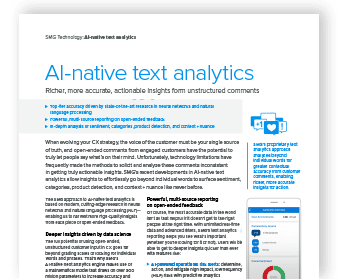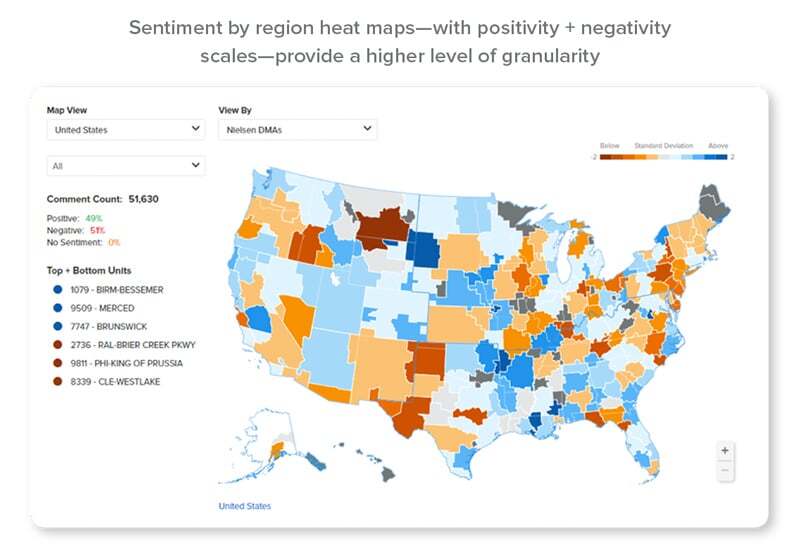Customer feedback analysis: Using AI text analytics to turn comments into action
Published on Aug 10, 2022

When evolving your customer experience (CX) strategy, the voice of the customer must be your single source of truth, and open-ended comments from engaged customers have the potential to truly let people say what’s on their mind. But finding the right approach to solicit and analyze these comments can be challenging.
The right customer feedback analytics technology evaluates experience data the way a human would—allowing insights to effortlessly go beyond individual words to surface sentiment, categories, product detection, and context + nuance.
In this blog, we’ll take a look at how AI text analytics can help you gain greater contextual accuracy from customer comments—enabling richer, more accurate insights for action.

AI-text analytics: Better insights for better business outcomes
Gaining deeper customer feedback insights with data science
The full potential of using open-ended, unstructured customer input in CX goes far beyond grading scales or looking for individual words and phrases. A robust AI text analytics engine—based on thorough research in neural networks and natural language processing—increases accuracy and the detail of sentiment in customer comments.
A “deep” model like this provides continual learning about context and nuance as it analyzes new input, helping you:
- Get an accurate read on customer sentiment
- Identify + group comments according to important categories
- Surface emerging trends across feedback channels
Let’s take a look at a real-life example of AI text analytics at work.
Real-world example: Convenience store brand
One popular c-store brand used text analytics to surface an issue many customers were experiencing at the pump—which was leading to negative experiences and a decline in repeat business.
Text analytics revealed dissatisfied customers were often making negative comments about credit cards. And when they did, it had a massive effect on overall satisfaction: 51%-lower than customers who didn’t mention credit cards. A deeper dive then revealed a full 20% of customers were having trouble with credit card readers.
The brand quickly took action by:
- Training call center agents to troubleshoot credit card reader issues
- Empowering store personnel to change or repair credit card readers on the spot
- Dispatching fewer technicians, which led to a quicker fix as a result of training sessions
These minor changes helped the brand drive a 60% reduction in time to resolve issues and $3M in annual savings from maintenance fees.
Enabling powerful multi-source customer experience reporting
Of course, the most accurate data in the world isn’t all that helpful if it doesn’t get to the right people at the right time. Text analytics reporting—leveraging real-time data and advanced filters—helps you see what’s important (whether you’re looking for it or not). Users can get to deeper insights quicker than ever with features like:
AI-powered risk alerts
While every comment matters, some carry more weight than others—especially when they pertain to issues that rarely pop up. While things like employee misconduct, operational hazards, and foodborne illness may only appear once in tens of thousands of comments, identifying and addressing those issues is paramount.
Advanced text analytics tools enable brands to mitigate operational risk with alerts on high-impact, low frequency events. Even more importantly, the AI technology identifies the mentions in real time and—depending on the scope of the issue—triggers the appropriate actions. Whether it’s providing managers with relevant coaching information or diagnosing and relaying potentially system-wide issues to central customer care teams, AI-based alerts keep brands one step ahead.
Sentiment and trend recognition
Before diving in to see what actions to take, it helps to get a handle on what consumers are talking about and how they feel about it. Company health reports—fed by multiple channels—provide executive users a quick glimpse into the sentiment behind comments across all feedback channels, as well as how that changes over time.
To go a click deeper and gain insight on specific channels and locations/regions, word clouds—an easy-to-read visual representation of word data depicted in different sizes to represent mention frequency—help users see:
- Recurring topics + accompanying sentiment
- Period-over-period comparisons on frequency of mentions
- Total volume of comments relating to each category
These tools serve as a definitive starting point on the path to insight. That means each layer of additional analysis is informed by an upfront understanding of how consumers feel about your brand.
Additionally, trend reports highlight emerging topics before they become widespread issues—helping brands avoid getting caught off-guard. With up to 2 years of historical comments and weekly, monthly, and quarterly trend lines, users get a real-time read into which categories bubble to the surface over specific time periods. And with prominent callouts for the percentage of relevant comments, total volume, and sentiment breakdown for each category, it’s that much easier to prioritize next steps.
Regional sentiment analysis
There’s no such thing as a uniform brand experience. Whether it’s an influx of cleanliness-related comments due to customers tracking in snow or supplier issues causing regional drops in taste scores, topics vary across markets. And it can be hard to balance striving for brand-wide consistency with pinpointing those specific areas of opportunity.
Interactive heat maps are an easy-to-read visual, providing a graphical representation of data that enable users to:
- Identify the regions where sentiment dips
- Hover over areas of interest for quick insight
- Drill down into specific categories to take informed action

With a full view of the customer experience across your geographic footprint, you can catch regional variances in perception and know exactly where to narrow your focus.
Adding context to CX scores
While self-serve reporting offers an endless source of on-demand insights, the right experience management provider will take it a step further to ensure you get the most out of your customer comments—using text analytics alongside other datasets to get to deeper insights that answer your most complex research questions. And when the data points to an issue, your teams can commit to digging in and finding the right solution.
In addition to that insight-focused partnership, your CX provider should also provide customized industry libraries and text benchmarks—populated with hundreds of millions of comments. These critical resources give you a deeper, more contextualized understanding of how customers perceive your brand relative to competitors, providing insights like:
- How often customers talk about the most important measures for your brand
- Frequency of employee mentions + how that impacts satisfaction
- The percentage of customers talking negatively about your staff
- The categories where customers think you’re better—or worse—than the rest
The importance of advanced text analytics for customer feedback
Leading brands know the quickest path to growth starts with listening to customers. But an increasingly complex customer journey spanning multiple touchpoints—including brick-and-mortar visits, digital interactions, contact center experiences, and online ratings and reviews—can make surfacing actionable insights seem like a daunting task.
To drive real change, brands require enterprise-level reporting platforms that translate mountains of data into targeted customer insights that drive business outcomes—consistently and efficiently.
Text analytics is an important part of the customer experience, so a high-functioning text analytics tool is imperative to any winning CX program. Without advanced AI text analytics technology, you aren’t harnessing the rich comments left by your customers—which means you’re missing out on even richer, more actionable insights.
Like the content in this blog? Download the AI text analytics one-pager for quick reference.
Related articles

Text analytics: Everything you need to know to create real customer experience impact
With rapid investment in customer experience management (CEM) platforms, leading brands know the quickest path to growth starts with listening to customers. But an increasingly complex customer journe

Turn Open-Ended Feedback into Actionable Insights With Text Analytics
Leading brands know the quickest path to growth starts with listening to customers. But an increasingly complex customer journey spanning multiple touchpoints can make surfacing actionable insights se

Bridge the Quantitative–Qualitative Gap in CX Feedback with Text Analytics
When it’s your job to listen to customers and act on their feedback, you absolutely have to be using text analytics. The world’s most successful brands know: it’s the surest way to glean rich insights